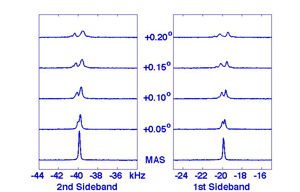High Field Magic Angle Spinning
Magic Angle Spinning (MAS) is a routine technique in solid state NMR, developed originally to suppress dipolar broadening. It works because the local field produced at an observed spin, due to dipolar coupling with neighboring spins, has components with symmetry like those of second rank spherical harmonics. When the sample is spun, local fields orthogonal to the spinning axis are rendered time dependent, and modulate the NMR signal at multiples of the spin rate. This produces a set of narrow spinning side bands at multiples of the spin rate, and a center band whose width is determined by the distribution of local fields along the rotation axis. For dipolar fields, the component along a spinning axis oriented at angle ß with respect to the static field is reduced by a factor of P2(cosβ). Thus at the "magic" angle, where P2(cosβ) = 0, dipolar broadening is suppressed. Complete suppression requires that the spin rate be much larger than the magnitude of the static coupling; this also reduces the side band intensities to zero.
Local fields from all anisotropic second rank tensor interaction, such as chemical shielding and first order quadrupole coupling, have the same symmetry and their line broadening is also, in principle, removable by magic angle spinning. However, large first order quadrupole couplings, such as ~200 kHz typical of deuterons and especially the much larger coupling found for 14N, present special problems. At present, the maximum spin rate achievable with commercial probes is about 35 kHz (up to 80 kHz has been reported using custom designs with very small rotors). This is sufficient to generate side bands, but suppression of the broadening requires very precise control of the magic angle. The present generation of commercial NMR probes permits reproducible adjustment of the magic angle with precision approaching 0.01o.
 This procedure is illustrated in Figure 1, which shows the first two sidebands of a 115 MHz spectrum of urea-d4/octanoic acid inclusion compound, obtained at 303 K with spin rate 20 kHz. The indicated angles were determined by matching the observed side band line shapes to simulated spectra. Exact MAS is determined by tuning for minimum sideband line width. There is ongoing discusssion in our laboratory whether this procedure is or is not more convenient than two-dimensional Satellite Transition MAS of 87Rb, when very accurate angle setting is required. More importantly, the Figure demonstrates that by purposely adjusting the rotor spinning axis slightly off the exact MAS condition, it is possible to controllably re-introduce a scaled-down quadrupole coupling. It is important to realize that the resulting "fine structure" of each side band is not simply a scaled down version of the static powder pattern. Instead, it is necessary to compute the exact line shape for finite spin rate by numerical procedures.
This procedure is illustrated in Figure 1, which shows the first two sidebands of a 115 MHz spectrum of urea-d4/octanoic acid inclusion compound, obtained at 303 K with spin rate 20 kHz. The indicated angles were determined by matching the observed side band line shapes to simulated spectra. Exact MAS is determined by tuning for minimum sideband line width. There is ongoing discusssion in our laboratory whether this procedure is or is not more convenient than two-dimensional Satellite Transition MAS of 87Rb, when very accurate angle setting is required. More importantly, the Figure demonstrates that by purposely adjusting the rotor spinning axis slightly off the exact MAS condition, it is possible to controllably re-introduce a scaled-down quadrupole coupling. It is important to realize that the resulting "fine structure" of each side band is not simply a scaled down version of the static powder pattern. Instead, it is necessary to compute the exact line shape for finite spin rate by numerical procedures.














